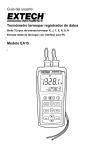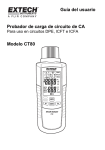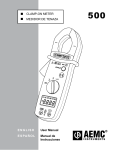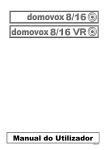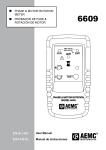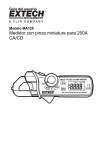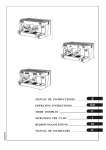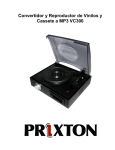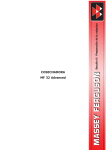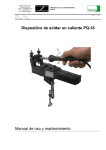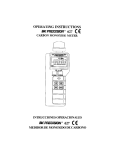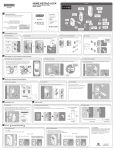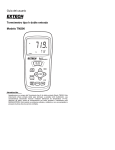Download Model #: 511
Transcript
CLAMP-ON METER MEDIDORES DE TENAZA ® INSTRUMENTS 511 512 MODEL 511 ® CLAMP METER INSTRUMENTS 600V CAT III 1000A MODEL 512 TRMS CLAMP METER 600V CAT III 1000A PEAK 1mS PEAK 1mS HOLD V A V A Ω 40A V Ω 40A OFF Hz MAX MIN MAX MIN 0 HOLD V 10 RANGE ∆ REL P– H P+ 20 600V CAT II 300V CAT III 40 600V 1000V Hz MAX MIN MAX MIN KΩ VA KHz MHz 30 600V ENGLISH OFF 0 10 RANGE ∆ REL P– H P+ 20 600V CAT II 300V CAT III KΩ VA KHz MHz 30 40 600V 1000V 600V User Manual E S PA Ñ O L Manual de Instrucciones ® INSTRUMENTS Statement of Compliance Chauvin Arnoux®, Inc. d.b.a. AEMC® Instruments certifies that this instrument has been calibrated using standards and instruments traceable to international standards. We guarantee that at the time of shipping your instrument has met its published specifications. An NIST traceable certificate may be requested at the time of purchase, or obtained by returning the instrument to our repair and calibration facility, for a nominal charge. The recommended calibration interval for this instrument is 12 months and begins on the date of receipt by the customer. For recalibration, please use our calibration services. Refer to our repair and calibration section at www.aemc.com. Serial #: _________________________________ Catalog #: 2117.67 / 2117.68 Model #: 511 / 512 Please fill in the appropriate date as indicated: Date Received: ____________________________ Date Calibration Due: _______________________ ® INSTRUMENTS Chauvin Arnoux®, Inc. d.b.a AEMC® Instruments www.aemc.com Table of Contents ENGLISH................................................................. 1 ESPAÑOL............................................................... 25 1.INTRODUCTION..................................... 3 1.1 International Electrical Symbols............4 1.2 Receiving Your Shipment......................4 1.3 Ordering Information.............................4 1.3.1 Replacement Parts.....................4 2. PRODUCT FEATURES............................ 5 2.1Description............................................5 2.2 Model 511/512 Control Features...........6 2.3 LCD Display..........................................7 3.SPECIFICATIONS................................... 8 3.1 Electrical Specifications........................8 3.2 Mechanical Specifications.....................9 3.3 Environmental Specifications..............10 3.4 Safety Specifications...........................10 4.OPERATION......................................... 11 4.1 Button Functions.................................11 4.1.1 Data Hold ................................11 4.1.2 Peak Hold Function .................11 4.1.3 MAX/MIN Function...................12 4.1.4 REL Function............................12 4.2 4.3 4.4 4.5 4.1.5 Manual Range Mode................12 AC Current Measurement...................13 AC Volt Measurement.........................14 DC Volt Measurement.........................15 Resistance Measurement...................16 Clamp-on Meter Models 511 and 512 1 4.6 4.7 4.8 4.9 Continuity Measurement.....................17 Diode Measurement............................18 Frequency Measuring - Voltage..........19 Frequency Measurement - Current.....20 5.MAINTENANCE.................................... 21 5.1Warning!..............................................21 5.2Cleaning..............................................21 5.3 Battery Replacement..........................22 Repair and Calibration.........................................23 Technical and Sales Assistance..........................23 Limited Warranty.................................................24 Warranty Repairs.................................................24 2 Clamp-on Meter Models 511 and 512 CHAPTER 1 INTRODUCTION Warning ● Read the user manual before operating and follow all safety information. ● Only use the meter as specified in this user manual. ● Never use this meter on a circuit with voltages greater than 600Vrms @ 50/60 Hz, Cat. III or 750V, Cat. II. ● Never measure current while the test leads are connected to the input jacks. ● Do not operate the meter if the body or test leads look damaged. ● Check the rotary range switch and make sure it is at the correct position before each measurement. ● Do not perform resistance and continuity test on a live circuit. ● Use extreme caution when measuring live systems with voltages greater than 60VDC or 30VAC. ● Use extreme care when working around bus bars and bare conductors. ● Do not use the meter in over range/overload conditions (OL). ● For accurate readings, change the battery when the symbol appears. Clamp-on Meter Models 511 and 512 3 1.1 International Electrical Symbols This symbol signifies that the instrument is protected by double or reinforced insulation. This symbol on the instrument indicates a WARNING and that the operator must refer to the user manual for instructions before operating the instrument. In this manual, the symbol preceding instructions indicates that if the instructions are not followed, bodily injury, installation/sample and product damage may result. Risk of electric shock. The voltage at the parts marked with this symbol may be dangerous. 1.2 Receiving Your Shipment Upon receiving your shipment, make sure that the contents are consistent with the packing list. Notify your distributor of any missing items. If the equipment appears to be damaged, file a claim immediately with the carrier and notify your distributor at once, giving a detailed description of any damage. Save the damaged packing container to substantiate your claim. 1.3 Ordering Information Clamp-on Meter Model 511......................Cat. #2117.67 Includes meter, pair of test leads (red/black with probe tips), one 9V battery, soft carrying case and a user manual. TRMS Clamp-on Meter Model 512........... Cat. #2117.68 Includes meter, pair of test leads (red/black with probe tips), one 9V battery, soft carrying case and a user manual. 1.3.1 Accessories and Replacement Parts Set of 2, 5 ft color-coded leads...................Cat. #2140.68 Replacement Pouch...................................Cat. #2118.94 4 Clamp-on Meter Models 511 and 512 CHAPTER 2 PRODUCT FEATURES 2.1Description The AEMC® Models 511 and 512 are general purpose professional clamp-on meters that measure up to the toughest standards. These meters offer a complete set of measurement ranges (AC Amps, AC Volts, DC Volts, Ohms, Continuity with beeper, Frequency from V or A, Diode Test function) and are in compliance with international safety and quality standards to ensure professional and reliable measuring tools. They are Auto-Ranging and provide the best measurement range and resolution for troubleshooting. They also have a high resolution 40A range. The Models 511 and 512 are sized for comfortable, onehanded operation. The tapered and hooked jaw design facilitates maneuvering in crowded wiring and breaker panels, making it easy to select conductors. The jaw opening accommodates one 750kcmil cable or two 350kcmil cables. The large and easy-to-read 4000-count LCD features comprehensive user information symbols, such as low battery, polarity, overload, and an analog bargraph for easy trend readings. Both models are equipped with a Data Hold function that freezes the measurement for later viewing, Min/Max, and a fast 1ms Peak Hold function for capture of signals. The Model 511 is average sensing and designed for traditional average responding electrical systems. The Model 512 is a True RMS clamp-on that provides RMS measurements for today’s non-linear electrical environments. Clamp-on Meter Models 511 and 512 5 2.2 Model 511/512 Control Features 1. Jaw Assembly - 1.575" (40 mm) 2. Lever for Jaw Opening/Closing 3. Rotary Range Selector Switch 4. Maximum/Minimum Button 5. LCD Display 6. COM (black) Input 7. Data Hold Button 8. Peak Hold Button 9. Range Button 10. Relative Button 11. Positive (red) Input 6 Clamp-on Meter Models 511 and 512 2.3 LCD Display Low Battery DC Input Polarity Indicator Zero (Relative) AC Inupt Auto Power Off Indication Positive Peak Detect Indication Continuity Beeper Enabled Diode Function Indication Negative Peak Detect Indication Data Hold Manual Range KΩ Resistance Measurement Indicator VA Voltage/Current Indicator KHz / MH Frequency Measurement Indicator Analog Bargraph Clamp-on Meter Models 511 and 512 7 CHAPTER 3 SPECIFICATIONS 3.1 Electrical Specifications Reference Conditions: 23°C ±5°C, 45 to 80% RH, True RMS for VAC and AAC accuracy are specified from 5% to 100% of range, crest factor 1.4 < CF < 3 at full scale & CF < 6 at half scale. AC Amperes (Auto-Ranging) Range Resolution 40A 0.01A 400A 0.1A 1000A 1A Accuracy (50/500Hz) Overload 800 Arms 1.9% Reading ± 5cts 1500Arms AC Volts (Auto-Ranging) Range Resolution 400V 0.1V 750V 1V Accuracy (50/500Hz) Overload 1.2% Reading ± 5cts 1000Vrms Accuracy (50/500Hz) Overload 0.75% Reading ± 2cts 1200Vrms Accuracy (50/500Hz) Overload 1% Reading ± 2cts 600Vrms DC Volts (Auto-Ranging) Range Resolution 400V 0.1V 1000V 1V Resistance - Ohms (Ω) 8 Range Resolution 400Ω 0.1Ω 4000Ω 1Ω Clamp-on Meter Models 511 and 512 Diode ( ) Range Active Region Overload Protection 0.6mA 600Vrms NOTE: Model 511 is average sensing Model 512 is TRMS Continuity ( ) Range Beeper Activation Overload < 40Ω 600Vrms Frequency (Hz) (Auto Ranging) Function Range Resolution Sensitivity Accuracy A - Hz 4K 1Hz 2Arms V - Hz 4K, 10K 1Hz 5Vrms 0.1% of Reading ± 1cts 3.2 Mechanical Specifications Digital Display: 3 3/4 digits LCD display (max reading 3999) Analog Display: Fast 42 segment analog bargraph display Symbol and Scale Range: Automatic according to range and input signal Polarity: displayed when negative signal applied to input Over Load: displayed when input signal exceeds range Sample Rate: 2 samples/sec for the digital display 20 samples/sec for the analog bargraph Clamp-on Meter Models 511 and 512 9 Power Supply: 9V, NEDA 1604 (6LR61) alkaline battery Low Battery Indication: displayed when the battery is below the required voltage Battery Life: Model 511: 150 hours approx Model 512: 120 hours approx Auto-Power Off: The meter will power itself OFF if there is no push button or rotary switch operation for 30 minutes. To deactivate this function, press the “MAX/MIN” button and keep it pressed down, then power up the probe. Jaw opening size: 1.575" (40mm) Dimension (L x W x D): 9.53 x 2.60 x 1.42" (242 x 66 x 36mm) Weight: 14.10 oz (400g) with batteries 3.3 Environmental Specifications Altitude: 2000 meters Operating Temperature: 32° to 104°F (0° to 40°C) < 80% RH, non-condensing Storage Temperature: 14° to 140°F (-10° to 60°C) < 70% RH, battery removed 3.4 Safety Specifications EN61010 600V CAT III, Pollution Degree: 2 EN61010 1000V CAT II, Pollution Degree: 2 *Specifications are subject to change without notice 10 Clamp-on Meter Models 511 and 512 CHAPTER 4 OPERATION 4.1 Button Functions 4.1.1 Data Hold • The last reading may be held on the display by pressing the HOLD button. The symbol will be displayed in data hold mode. • When the held data is no longer needed, release the hold function by pressing the HOLD button again. 4.1.2 Peak Hold Function • The Models 511 and 512 are built with 1ms peak hold function on AAC, VAC and VDC ranges. • Calibration is necessary before performing a peak hold operation. • To start the calibration process, press and hold the PEAK button for 2 seconds. “CAL” will display on the LCD and the offset will be calculated and kept in the meter. or by pressing the • After calibration, choose either Peak Hold button to keep the peak reading. • Pressing the PEAK button for 2 seconds will return the meter back to normal operation. • Once the function range is changed, the meter will need another calibration for peak measurement. Clamp-on Meter Models 511 and 512 11 4.1.3 MAX/MIN Function • The Models 511 and 512 are built with MAX/MIN function at AAC, VAC and VDC ranges. • Pressing the MAX/MIN button once will set the meter to MAX mode. • Pressing it twice will set the meter to MIN mode. • Pressing it three times will display the present reading and still keep track of the MAX and MIN change. This mode will also indicate a blinking MAX/MIN symbol. • Pressing the MAX/MIN button for more than 2 seconds will set the meter back to normal operation. 4.1.4 REL Function • The Models 511 and 512 are built with REL function at AAC, VAC and VDC ranges. • Pressing the ∆REL button once will change the zero to the present reading and the relative value will show on the LCD. • Pressing it twice will display the relative zero point. This symbol. mode will also indicate a blinking • Pressing the ∆REL button for more than 2 seconds will set the meter back to normal operation. 4.1.5 Manual Range Mode • The Models 511 and 512 operate in an Auto-ranging mode (AUTO displayed) by default. Manual-ranging in VAC/DC, and A (1000A) is available. • Press and hold the RANGE button. When the range changes (decimal point shift), release the button. • The symbol is displayed in the manual range mode. • Press and hold the RANGE button for more than 2 seconds to re-enter the Auto-ranging mode. 12 Clamp-on Meter Models 511 and 512 4.2 AC Current Measurement NOTE: Remove the test leads before measuring current • Turn the rotary range switch to the range. • Press the lever to open the jaws. • Clamp the jaws around the conductor to be measured. • If reading is unstable and is hard to read, push the HOLD button and read the measurement. WARNING: If overload " " is displayed, unclamp the meter immediately . Clamp-on Meter Models 511 and 512 13 4.3 AC Volt Measurement WARNING: Maximum Input Voltage is 600V. Do not exceed this voltage to avoid electrical shock and/or damage to the instrument. • Turn the rotary range switch to the range. • Insert the red test lead to the red "+" input jack and the black lead to the black "COM" input jack. • Bring the test probe tips into contact with the test points. • If reading is unstable and is hard to read, push the HOLD button and read the measurement. WARNING: Immediately unclamp the meter from the conductor under test if overload " " is displayed. 14 Clamp-on Meter Models 511 and 512 4.4 DC Volt Measurement • Turn the rotary range switch to the range. • Insert the red test lead to the red "+" input jack and the black lead to the black "COM" input jack. • Bring the test probe tips into contact with the test points. • If reading is unstable and is hard to read, push the HOLD button and read the measurement. WARNING: Immediately unclamp the meter from the conductor under test if overload " " is displayed. Clamp-on Meter Models 511 and 512 15 4.5 Resistance Measurement • Turn the rotary range switch to the range. • Insert the red test lead to the red "+" input jack and the black lead to the black "COM" input jack. • Bring the test probe tips into contact with the sample under test. WARNING: Immediately unclamp the meter from the conductor under test if overload " " is displayed. WARNING: When making a resistance mea surement, make sure that the power is off (dead circuit), and that all capacitors in the measured circuit are fully discharged. 16 Clamp-on Meter Models 511 and 512 4.6 Continuity Measurement WARNING: When testing continuity, make sure that there is no power in the tested sample or circuit (dead circuit). This may be checked by using the voltage functions. • Turn the rotary range switch to the range. • Insert red test lead to the red "+" input jack and the black lead to the black "COM" input jack. • Bring the test probe tips into contact with the sample under test. • If the resistance is less than 40Ω, the beeper emits a continuous sound. WARNING: Immediately unclamp the meter from the conductor under test if overload " " is displayed. Clamp-on Meter Models 511 and 512 17 4.7 Diode Measurement WARNING: Make sure that there is no power in the tested sample or circuit (dead circuit). • Turn the rotary range switch to the range. • Insert red test lead to the red “+” input jack and the black lead to the black “COM” input jack. • Bring the test probe tips into contact with the sample under test. • If the polarity of the test leads are reversed with diode polarity, the digital reading shows ≥ 3.0. This can be used for distinguishing anode and cathode terminals of a diode. ® INSTRUMENTS MODEL 514 TRMS CLAMP METER 600V CAT III 1000A PEAK 1mS HOLD A 400 V 1000 Ω 40 OFF Hz ∆ REL MAX MIN V 0 10 20 600V CAT III 1000V CAT II 30 40 600V 1000V 600V 18 Clamp-on Meter Models 511 and 512 4.8 Frequency Measuring Using Voltage Input • Turn the rotary range switch to the range. • Insert red test lead to the red "+" input jack and the black lead to the black "COM" input jack. • Bring the test probe tips into contact with the sample under test. WARNING: Immediately unclamp the meter from the conductor under test if overload " " is displayed. Clamp-on Meter Models 511 and 512 19 4.9 Frequency Measurement Using Current Input NOTE: Remove the test leads before measuring current • Turn the rotary range switch to the range. • Press the lever to open the jaws. • Clamp the jaws around the conductor to be measured. WARNING: Do not use both voltage and cur rent inputs at the same time when measuring frequency. This may be dangerous. Erroneous readings will occur if both inputs are used at the same time. 20 Clamp-on Meter Models 511 and 512 CHAPTER 5 MAINTENANCE 5.1 Warning! • Remove the test leads on any input before opening the case. • Do not operate the clamp-on probe without a battery case cover. • To avoid electrical shock, do not attempt to perform any servicing unless you are qualified to do so. • To avoid electrical shock and/or damage to the instrument, do not get water or other foreign agents into the probe. 5.2Cleaning • To clean the probe, wipe the case with a damp cloth and mild detergent. • Do not use abrasives or solvents. • Do not get water inside the case. This may lead to electrical shock or damage to the instrument. 5.3 Battery Replacement • The Clamp-on Meter Models 511 and 512 are powered by a 9V battery. The symbol will appear on the LCD display when the supply voltage drops below proper operating range. This indicates that the battery needs to be changed. Clamp-on Meter Models 511 and 512 21 • The meter must be in the OFF position and disconnected from any circuit or input. • Place the meter face down and loosen the battery cover screw with a flat head screwdriver. • Replace the old battery with a new 9V battery. • Replace the battery compartment cover and tighten down the screw. 22 Clamp-on Meter Models 511 and 512 Repair and Calibration To ensure that your instrument meets factory specifications, we recommend that it be submitted to our factory Service Center at one-year intervals for recalibration, or as required by other standards or internal procedures. For instrument repair and calibration: You must contact our Service Center for a Customer Service Authorization Number (CSA#). This will ensure that when your instrument arrives, it will be tracked and processed promptly. Please write the CSA# on the outside of the shipping container. If the instrument is returned for calibration, we need to know if you want a standard calibration, or a calibration traceable to N.I.S.T. (Includes calibration certificate plus recorded calibration data). Chauvin Arnoux®, Inc. d.b.a. AEMC® Instruments 15 Faraday Drive • Dover, NH 03820 USA Phone: (800) 945-2362 or (603) 749-6434 (Ext. 360) Fax: (603) 742-2346 or (603) 749-6309 [email protected] (Or contact your authorized distributor) Costs for repair, standard calibration, and calibration traceable to N.I.S.T. are available. NOTE: A CSA# must be obtained before returning any instrument. Technical and Sales Assistance If you are experiencing any technical problems, or require any assistance with the proper operation or application of your instrument, please call, mail, fax or e-mail our technical support hotline: Chauvin Arnoux®, Inc. d.b.a. AEMC® Instruments 200 Foxborough Blvd • Foxborough, MA 02035, USA Phone: (800) 343-1391 or (508) 698-2115 Fax: (508) 698-2118 [email protected] www.aemc.com NOTE: Do not ship instruments to our Foxborough, MA address. Clamp-on Meter Models 511 and 512 23 Limited Warranty The Models 511 and 512 are warranted to the owner for a period of one year from the date of original purchase against defects in manufacture. This limited warranty is given by AEMC® Instruments, not by the distributor from whom it was purchased. This warranty is void if the unit has been tampered with, abused or if the defect is related to service not performed by AEMC® Instruments. For full warranty coverage detail and registration, go to www.aemc.com What AEMC® Instruments will do: If a malfunction occurs within the one-year period, you may return the instrument to us for repair or replacement free of charge, provided we have your registration information on file or proof of purchase. AEMC® Instruments will, at its option, repair or replace the faulty material. REGISTER ONLINE AT: www.aemc.com Warranty Repairs What you must do to return an Instrument for Warranty Repair: First, request a Customer Service Authorization Number (CSA#) by phone or by fax from our Service Department (see address below), then return the instrument along with the signed CSA Form. Please write the CSA# on the outside of the shipping container. Return the instrument, postage or shipment pre-paid to: Chauvin Arnoux®, Inc. d.b.a. AEMC® Instruments Service Dept • 15 Faraday Dr • Dover, NH 03820 USA Phone: (800) 945-2362 or (603) 749-6434 (Ext. 360) Fax: (603) 742-2346 or (603) 749-6309 [email protected] Caution: To protect yourself against in-transit loss, we recommend you insure your returned material. NOTE: All customers must obtain a CSA# before returning any instrument. 24 Clamp-on Meter Models 511 and 512 Tabla de Contenidos ENGLISH................................................................. 1 ESPAÑOL............................................................... 25 1.INTRODUCCIÓN................................... 27 1.1 Símbolos Eléctricos Internacionales...28 1.2 Recepción de su embarque................28 1.3 Información para poner una orden......28 1.3.1 Accesorios de Repuesto..........28 2.CARACTERÍSTICAS............................. 29 2.1Descripción.........................................29 2.2 Controles de los Modelos 511/512......30 2.3 Características de la Pantalla.............31 3.ESPECIFICACIONES............................ 32 3.1 Especificaciones Eléctricas.................32 3.2 Especificaciones Mecánicas...............33 3.3 Especificaciones Ambientales.............34 3.4 Especificaciones de Seguridad...........34 4.OPERACIÓN......................................... 35 4.1 Función de Botóns..............................35 4.1.1 Mantener Lectura ....................35 4.1.2 Mantener Valor de Pico............35 4.1.3 Función MAX/MIN....................36 4.1.4 Función REL.............................36 4.1.5 Modo Rango Manual................36 4.2 Medición de Corriente CA...................37 4.3 Medición de Volt CA............................38 4.4 Medición de Volt CD...........................39 Medidores de Tenaza Modelos 511/512 25 4.5 4.6 4.7 4.8 4.9 Medición de Resistencia.....................40 Prueba de Continuidad.......................41 Prueba de Diodo.................................42 Medición de Frecuencia (voltaje)........43 Medición de Frecuencia (corriente)....44 5.MANTENIMIENTO................................ 45 5.1Advertencia.........................................45 5.2Limpieza..............................................45 5.3 Reemplazo de la Batería....................46 Reparación y Calibración....................................47 Asistencia Técnica y de Ventas...........................47 Garantía Limitada................................................48 Reparaciones bajo Garantía...............................48 26 Medidores de Tenaza Modelos 511/512 CAPÍTULO 1 INTRODUCCIÓN Advertencia • Lea el manual de usuario antes de operar el instrumento y siga todas las instrucciones de seguridad. • Use el medidor sólo como se especifica en este manual de usuario. De otra forma se puede dañar la protección del instrumento. • Nunca utilice este medidor en un circuito con voltajes superiores a 600Vrms @ 50/60Hz, Cat. III o 750V, Cat. II. • Nunca mida corriente mientras los cables de prueba estén conectados a las entradas. • No opere el medidor si la carcasa o los cables de prueba están dañados. • Revise el selector de rango rotatorio y asegúrese que está en la posición correcta antes de cada medición. • No realice pruebas de resistencia ni de continuidad en un circuito vivo. • Sea extremadamente cuidadoso cuando mida en circuitos vivos con voltajes superiores a 60VCD o 30VCA. • Tenga mucho cuidado al trabajar cerca de barras bus y conductores desnudos. • No utilice el medidor fuera de rango o en condiciones de sobrecarga (OL). • Para evitar lecturas erróneas, cambie la batería cuando aparece el símbolo . Medidores de Tenaza Modelos 511/512 27 1.1 Símbolos Eléctricos Internacionales Este símbolo significa que el instrumento esta protegido por un doble aislamiento o un aislamiento reforzado. Utilice piezas de repuesto especificadas por AEMC cuando repare el instrumento. Este símbolo en el instrumento significa ADVERTENCIA en este caso consulte el manual de instrucciones antes de utilizar el aparato. En el supuesto que aparezca esta señal, significara no se han seguido las instrucciones de uso, si no se respetan o realizan correctamente, pueden ocasionar un accidente corporal o dañar el equipo o las instalaciones. Riesgo de choque eléctrico. Los componentes marcados con este símbolo pueden ser peligrosos. 1.2 Recepción de su embarque Luego de recibido su embarque, asegúrese que el contenido coincide con la guía de despacho. Avise a su distribuidor sobre cualquier parte faltante. Si el equipo aparece dañado, presente un reclamo inmediatamente al transportador y avise inmediatamente a su distribuidor, dando una descripción detallada de los daños. Conserve el empaque dañado para respaldar su reclamo. No utilice un instrumento que aparezca dañado. 1.3 Información para poner una orden Medidores de Tenaza Modelo 511........... Cat. #2117.67 Incluye Manual de usuario, cables de prueba, 9V batería, Estuche de Trasporte Blando. Medidores de Tenaza Modelo 512........... Cat. #2117.68 Incluye Manual de usuario, cables de prueba, 9V batería, Estuche de Trasporte Blando. 1.3.1 Accesorios de Repuesto Cables 5 ft..................................................Cat. #2140.68 Estuche de Repuesto.................................Cat. #2118.94 28 Medidores de Tenaza Modelos 511/512 CAPÍTULO 2 CARACTERÍSTICAS DEL PRODUCTO 2.1Descripción Los Medidores de Tenaza Modelos 511 y 512 de AEMC® Instruments son instrumentos profesionales de uso general. Un diseño de caja robusto, materiales de poli carbonato de calidad, rangos completos y acatamiento de estándares de seguridad y de calidad internacionales garantizan una herramienta de medición profesional y confiable. Ambos modelos son de auto rango y disponen de las funciones Amperes CA y Volts CA, más Volts CD, Ohms, continuidad con bíper, Frecuencia (desde V y A) y prueba de diodos. El Modelo 511 es sensible al promedio calibrado para RMS y diseñado para los sistemas eléctricos tradicionales que responden al valor promedio. El Modelo 512 es una tenaza RMS Verdadera para mediciones RMS en los ambientes eléctricos no-lineales de hoy. Medidores de Tenaza Modelos 511/512 29 2.2 Controles de los Modelos 511/512 1. Tenaza 2. Palanca para abrir/cerrar la tenaza 3. Selector de rango rotatorio 4. Botón Máximo/Mínimo 5. Pantalla LCD 6. Entrada COM (negro) 7. Botón mantener lectura 8. Botón mantener lectura de pico 9. Botón de Rango 10. Botón Valor Relativo 11. Entrada Positiva (roja) 30 Medidores de Tenaza Modelos 511/512 2.3 Características de la Pantalla Batería Baja Entrada CD Indicador de Polaridad Indicador de Valor Relativo Entrada CA Indicador de Apagado Automático Indicador de Detección de Pico Positivo Bíper de Continuidad Habilitado Indicador de Función Diodo Indicador de Detección de Pico Negativo Mantener Lectura Indicador de Rango Manual KΩ Indicador de Medición de Resistencia VA Indicador de Medición de Voltaje y Corriente KHz / MH Medición de Frecuencia Gráfico de Barras analógico Medidores de Tenaza Modelos 511/512 31 CAPÍTULO 3 ESPECIFICACIONES 3.1 Especificaciones Eléctricas La exactitud está dada bajo las siguientes condiciones de referencia: 23°C ±5°C, 45 a 80% HR, para la exactitud de VCA y ACA se especifica un RMS verdadero desde 5% a 100% del rango, un factor de cresta 1.4 <FC <3 a escala completa & FC <6 a media escala. Amperes CA (Auto Rango) Rango Resolución 40A 0.01A 400A 0.1A 1000A 1A Exactitud Sobrecarga 800 Arms 1.9% Lectura ± 5cts 1500Arms Volts CA (Auto Rango) Rango Resolución 400V 0.1V 750V 1V Exactitud (50/500Hz) Sobrecarga 1.2% Lectura ± 5cts 1000Vrms Exactitud Sobrecarga 0.75% Lectura ± 2cts 1200Vrms Exactitud Sobrecarga 1% Lectura ± 2cts 600Vrms Volts CD (Auto Rango) Rango Resolución 400V 0.1V 1000V 1V Resistencia - Ohms (Ω) Rango Resolución 400Ω 0.1Ω 4000Ω 1Ω 32 Medidores de Tenaza Modelos 511/512 Diodo ( ) Rango Región Activa Protección de sobrecarga 0.6mA 600Vrms NOTA: El Modelo 511 es sensible al promedio El Modelo 512 es RMS verdadero (TRMS) Continuidad ( Rango ) Activación del Bíper Sobrecarga < 40Ω 600Vrms Frecuencia (Hz) (Auto Rango) Función Rango Resolución Sensibilidad Exactitud A - Hz 4K 1Hz 2Arms V - Hz 4K, 10K 1Hz 5Vrms 0.1% de Lect. ± 1cts 3.2 Especificaciones Mecánicas Pantalla Digital: Pantalla LCD con dígitos de 3 3/4 (máx. lectura 3999) Pantalla Analógica: Presentación rápida en gráfico de barras de 42 segmentos Símbolos y rangos de Escala: Automáticos según rango y señal de entrada Polaridad: Al aplicar una señal negativa a la entrada se muestra Sobrecarga: Cuando la señal de entrada excede el rango se muestra Velocidad de Muestreo: 2 muestras/seg. para la pantalla digital 20 muestras/seg. para el gráfico de barras analógico Medidores de Tenaza Modelos 511/512 33 Alimentación: 9V, NEDA 1604 o 6F22 o 006P Indicador de Batería Baja: Cuando el voltaje de la batería está por debajo de lo requerido se muestra Vida de la Batería: Modelo 511: 150 hrs. aprox. Modelo 512: 120 hrs. aprox. Auto Apagado: El medidor se apaga por si solo, si no se acciona ningún botón o el selector rotatorio durante 30 minutos. Para desactivar esta función, presione el botón “MAX MIN” y manténgalo presionado mientras enciende el instrumento. Abertura de la Tenaza: 1.575" (40 mm) Dimensión (Largo x Ancho x Alto): 9.53 x 2.60 x 1.42” (242 x 66 x 36mm) Peso: 14.10 oz (400g) con baterías 3.3 Especificaciones Ambientales Altura: 2000 metros Temperatura de Operación: 32° a 104°F (0° a 40°C) < 80% HR, no-condensante Temperatura de almacenamiento: 14° a 140°F (-10° a 60°C) < 70% HR, sin batería 3.4 Especificaciones de Seguridad EN 61010, 600V, CAT III, Contaminación Grado: 2 EN 61010, 1000V, CAT II, Contaminación Grado: 2 34 Medidores de Tenaza Modelos 511/512 CAPÍTULO 4 OPERACIÓN 4.1 Función de Botóns 4.1.1 Mantener Lectura • La última lectura puede mantenerse en la pantalla presionando el botón Hold. Se mostrará el símbolo en el modo mantener lectura. • Cuando no necesite más el dato, libere la función mantener lectura presionando el botón Hold nuevamente. 4.1.2 Mantener Valor de Pico • Los Modelos 511 y 512 poseen una función mantener valor de pico de 1ms en los rangos ACA, VCA y VCD. • Antes de efectuar la operación mantener valor de pico es necesaria una calibración. • Para iniciar el proceso de calibración, presione y mantenga presionado el botón de pico por 2 segundos. Se mostrará “CAL” en la pantalla LCD y se calculará y almacenará en el medidor el corrimiento. o presio• Después de la calibración, seleccione nando el botón mantener valor de pico para guardar la lectura de pico. • Presionando el botón pico durante 2 segundos el medidor volverá a la operación normal. • Una vez que se cambia el rango de función, el medidor requiere una nueva calibración para otra medición de valor de pico. Medidores de Tenaza Modelos 511/512 35 4.1.3 Función MAX/MIN • Los Modelos 511 y 512 poseen una función MAX/MIN para los rangos ACA, VCA y VCD. • Presionando el botón MAX/MIN una vez se deja al medidor en el modo MAX. • Presionando el botón MAX/MIN dos veces se deja al medidor en el modo MIN. • Presionando el botón MAX/MIN tres veces se muestra la lectura del momento manteniendo aún un seguimiento de los cambios de MAX y MIN. Este modo presenta además el símbolo MAX/MIN destellando. • Presionando el botón MAX/MIN por más de 2 segundos se vuelve el medidor a la operación normal. 4.1.4 Función REL • Los Modelos 511 y 512 poseen una función REL para los rangos ACA, VCA y VCD. • Presionando el botón REL una vez se desplaza el cero hasta la lectura del momento y se mostrará en la pantalla LCD el valor relativo. • Presionando el botón REL dos veces se mostrará el punto cero relativo. Este modo también presenta el símbolo REL destellando. • Presionando el botón REL por más de 2 segundos se vuelve el medidor a la operación normal. 4.1.5 Modo Rango Manual • Los Modelos 511 y 512 operan en forma preestablecida en modo auto rango (se muestra AUTO en pantalla). Existe un modo de rango manual para V (CA o CD) y A (1000A). • Presione y mantenga presionado el botón RANGE. Cuando cambie el rango (se desplaza el punto decimal), libere el botón. • En el modo rango manual se muestra el símbolo . • Presione y mantenga presionado el botón RANGE por más de 2 segundos para volver al modo AUTO rango. 36 Medidores de Tenaza Modelos 511/512 4.2 Medición de Corriente CA Nota: Retire los cables de prueba antes de medir corriente. • Gire el selector de rango rotatorio a la posición . • Presione la palanca para abrir la tenaza. • Coloque la tenaza alrededor del conductor que desea medir. • Si la lectura es inestable y difícil de leer, presione el botón HOLD y tome la lectura. Advertencia: Retire inmediatamente las puntas de prueba desde el circuito que se mide si aparece " ". Medidores de Tenaza Modelos 511/512 37 4.3 Medición de Volt CA Advertencia: Nunca utilice este medidor en un circuito con voltajes superiores a 600Vrms @ 50/60Hz, Cat. III o 750V, Cat. II. • Gire el selector de rango rotatorio a la posición . • Inserte el cable de prueba rojo en la entrada "+" roja y el cable de prueba negro en la entrada "COM" negra. • Haga contacto con las puntas en los puntos de medición. • Si la lectura es inestable y difícil de leer, presione el botón HOLD y tome la lectura. Advertencia: Retire inmediatamente las puntas de prueba desde el circuito que se mide si aparece "OL". 38 Medidores de Tenaza Modelos 511/512 4.4 Medición de Volt CD • Gire el selector de rango rotatorio a la posición . • Inserte el cable de prueba rojo en la entrada "+" roja y el cable de prueba negro en la entrada "COM" negra. • Haga contacto con las puntas en los puntos de medición. • Si la lectura es inestable y difícil de leer, presione el botón HOLD y tome la lectura. Advertencia: Retire inmediatamente las puntas de prueba desde el circuito que se mide si aparece "OL". Medidores de Tenaza Modelos 511/512 39 4.5 Medición de Resistencia • Gire el selector de rango rotatorio a la posición . • Inserte el cable de prueba rojo en la entrada "+" roja y el cable de prueba negro en la entrada "COM" negra. • Haga contacto con las puntas de prueba en la muestra a medir. Advertencia: Retire inmediatamente las puntas de prueba desde el circuito que se mide si aparece "OL". Advertencia: Al hacer una medición de resist encia, asegúrese que no hay energía (circuito muerto). También es importante que todos los condensadores del circuito que se mide estén totalmente descargados. 40 Medidores de Tenaza Modelos 511/512 4.6 Prueba de Continuidad Advertencia: Al probar continuidad, asegúrese que no hay energía en la muestra o en el circuito bajo prueba (circuito muerto). Esto puede comprobarse usando las funciones de voltaje. • Gire el selector de rango rotatorio a la posición . • Inserte el cable de prueba rojo en la entrada “+”roja y el cable de prueba negro en la entrada “COM” negra. • Haga contacto con las puntas de prueba en la muestra a medir. • Si la resistencia es menor que 40Ω, el bíper emite un sonido continuo. • Si aparece ≥ 3.0, la resistencia excede el rango de medición o el circuito está abierto. Advertencia: Retire inmediatamente las puntas de prueba desde el circuito que se mide si aparece "OL". Medidores de Tenaza Modelos 511/512 41 4.7 Prueba de Diodo Advertencia: Asegúrese que no hay energía en la muestra o en el circuito bajo prueba (circuito muerto). • Gire el selector de rango rotatorio a la posición • Inserte el cable de prueba rojo en la entrada “+”roja y el cable de prueba negro en la entrada “COM” negra. • Haga contacto con las puntas de prueba en la muestra a medir. • Si se invierte la polaridad de los cables de prueba respecto a la polaridad del diodo, la lectura digital mostrará ≥ 3.0. Esto puede usarse para distinguir ánodo de cátodo en los terminales del diodo. ® INSTRUMENTS MODEL 514 TRMS CLAMP METER 600V CAT III 1000A PEAK 1mS HOLD A 400 V 1000 Ω 40 OFF Hz ∆ REL MAX MIN V 0 10 20 600V CAT III 1000V CAT II 30 40 600V 1000V 600V 42 Medidores de Tenaza Modelos 511/512 4.8 Medición de Frecuencia usando la entrada de voltaje • Gire el selector de rango rotatorio a la posición Hz. • Inserte el cable de prueba rojo en la entrada “+”roja y el cable de prueba negro en la entrada “COM” negra. • Haga contacto con las puntas de prueba en el circuito a medir. • Si la lectura es inestable y difícil de leer, presione el botón HOLD y tome la lectura. Advertencia: Retire inmediatamente las puntas de prueba desde el circuito que se mide si aparece "OL". Medidores de Tenaza Modelos 511/512 43 4.9 Medición de Frecuencia usando la entrada de corriente NOTA: Desconecte los cables de prueba antes de medir frecuencia a través del modo corriente (tenaza). • Gire el selector de rango rotatorio a la posición . • Presione la palanca para abrir la tenaza. • Coloque la tenaza alrededor del conductor a medir. • Si la lectura es inestable y difícil de leer, presione el botón HOLD y tome la lectura. Advertencia: Al medir frecuencia no utilice las entradas de voltaje y de corriente simultáneamente. Esto puede ser peligroso. Si se usan ambas entradas al mismo tiempo se producirán lecturas erróneas. 44 Medidores de Tenaza Modelos 511/512 CAPÍTULO 5 MANTENIMIENTO 5.1 Advertencia! • Retire los cables de prueba de las entradas antes de abrir la caja. No opere el medidor de tenaza sin la cubierta del compartimiento de la batería. • Para evitar un choque eléctrico, no intente realizar ninguna reparación si no está calificado para hacerla. • Para evitar un choque eléctrico y/o daño al instrumento no permita que entre agua u otro agente extraño al interior del medidor. 5.2Limpieza • Para limpiar el medidor, frote la caja con un paño húmedo y un detergente suave. No use abrasivos ni solventes. • No permita que entre agua dentro de la caja. Esto puede conducir a un choque eléctrico o dañar el instrumento. Medidores de Tenaza Modelos 511/512 45 5.3 Reemplazo de la Batería • Los Modelos 511 y 512 son alimentados por una batería de 9V. Cuando el voltaje de alimentación cae por debajo del rango de operación apropiado aparece en la pantalla LCD el símbolo . Esto indica que se debe reeemplazar la batería. • El medidor debe estar en la posición OFF y desconectado de cualquier circuito o entrada. • Coloque el medidor cara abajo y suelte el tornillo de la cubierta de la batería con un destornillador de paleta. • Reemplace la batería vieja por una nueva de 9V. • Reponga la tapa del compartimiento de batería y apriete el tornillo. 46 Medidores de Tenaza Modelos 511/512 Reparación y Calibración Para asegurar que su instrumento cumple con las especificaciones de fábrica, recomendamos que sea enviado al Centro de Servicio de la fábrica para re-calibración, anualmente o según lo requieran otros estándares o procedimientos internos. Para la reparación y calibración del instrumento: Usted debe contactar nuestro Centro de Servicio para obtener un Número de Autorización de Servicio al Cliente (CSA#). Esto le asegurará que cuando llegue su instrumento, será ingresado y procesado con prontitud. Por favor escriba el CSA# en el exterior del envase. . Si el instrumento se envía para calibración, necesitamos saber si desea una calibración estándar o una calibración según N.I.S.T. (incluye certificado de calibración más registro de los datos de calibración). Chauvin Arnoux®, Inc. d.b.a. AEMC® Instruments 15 Faraday Drive • Dover, NH 03820 USA Tel: (800) 945-2362 or (603) 749-6434 (Ext. 360) Fax: (603) 742-2346 or (603) 749-6309 [email protected] (O contacte su distribuidor autorizado) Los Costos de reparación, calibración estándar y calibración según N.I.S.T. están disponibles. NOTA: Todos los clientes deben obtener un CSA# antes de enviar un instrumento. Asistencia Técnica y de Ventas Si tiene cualquier problema técnico o necesita ayuda para operar correctamente su instrumento o en sus aplicaciones, por favor llame, escriba, envíe un fax o correo electrónico a nuestro soporte técnico: Chauvin Arnoux®, Inc. d.b.a. AEMC® Instruments 200 Foxborough Blvd • Foxborough, MA 02035, USA Phone: (800) 343-1391 or (508) 698-2115 Fax: (508) 698-2118 [email protected] www.aemc.com NOTA: No envíe instrumentos a nuestra dirección en Foxborough, MA. Medidores de Tenaza Modelos 511/512 47 Garantía Limitada El Modelo 511/512 es garantizado al propietario por defectos de fabricación, por un período de un año desde la fecha original de compra. Esta garantía limitada es dada por AEMC® Instruments, no por el distribuidor a quien se compró el instrumento. Esta garantía queda viciada si la unidad ha sido intervenida, abusada o si la falla se relaciona con un servicio no realizado por AEMC® Instruments. Para detalles completos sobre la cobertura de la garantía y registro, visite www.aemc.com Lo que AEMC® Instruments hará: Si ocurre una falla de funcionamiento dentro de un año, usted puede devolvernos el instrumento para su reparación o reemplazo sin cargo, siempre y cuando tengamos su información de registro de garantía o un comprobante de compra. AEMC® Instruments reparará o reemplazará el material defectuosos, a su discreción. Registro En línea en: www.aemc.com Reparaciones bajo Garantía Lo que Usted debe hacer para enviar un Instrumento para Reparación bajo Garantía: Primero, solicite un Número de Autorización de Servicio al Cliente (CSA#) por teléfono o por fax a nuestro Departamento de Servicio (vea la dirección abajo), luego envíe el instrumento junto con el formulario CSA firmado. Por favor escriba el CSA# en el exterior del envase. Envíe el instrumento con el franqueo o flete prepagado a: Chauvin Arnoux®, Inc. d.b.a. AEMC® Instruments Service Department • 15 Faraday Dr • Dover, NH 03820 USA Tel: (800) 945-2362 or (603) 749-6434 (Ext. 360) Fax: (603) 742-2346 or (603) 749-6309 [email protected] Precaución: Para protegerse contra pérdidas en tránsito, le recomendamos asegurar su mercadería. NOTA: Todos los clientes deben obtener un CSA# antes de enviar un instrumento. 48 Medidores de Tenaza Modelos 511/512 ® INSTRUMENTS 09/11 99-MAN 100223 v9 Chauvin Arnoux®, Inc. d.b.a. AEMC® Instruments 15 Faraday Drive • Dover, NH 03820 USA www.aemc.com





















































